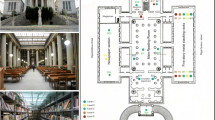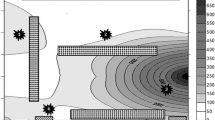Abstract
The aim of this study was to analyze the viable fungi in the air of indoor environments of the National Archive of the Republic of Cuba (NARC). The samples were taken in fifteen areas (five points for the three floors) at 2 days (rainy and dry seasons) using a biocolector SAS in 3 h: 10:00 a.m., 1:00 p.m. and 4:00 p.m. The fungal concentration was indicated as colony forming units per cubic meter of air (cfu/m3 of air). It was concluded that indoor air of the NARC was not polluted due to the average fungal concentration that was obtained (59 and 327 cfu/m3 of air in rainy and dry seasons, respectively). In front of the electric transformers, the fungal concentration was significantly higher than those obtained along the corridors of the lower-ground floor. A trend to the increasing of fungal concentration was observed: when the floors were increased, in dry season was higher than rainy season, where also there was biggest fungal diversity. Among the fungal genera isolated, Aspergillus had the highest relative frequency of appearance, and in dry season, it was isolated Actinobacillus sp. (Actinomycetes). Six fungal species were isolated in both samplings: Aspergillus alliaceus, Aspergillus niger, Cladosporium cladosporioides, Fusarium oxysporum, Penicillium chrysogenum and Mucor racemosus. All of fungal species isolated have high biodeteriogenic capacity, and the 61 % showed pathogenic attributes.







Similar content being viewed by others
References
Anaya, M., Castro, M., Borrego, S. F., & Cobo, H. C. (2015). Influencia del campo magnético sobre la distribución de los hongos en el aire de un local cerrado. Revista de la Sociedad Venezolana de Microbiología, 35, 47–52.
Barnett, H. L., & Hunter, B. B. (2003). Illustrated genera of imperfect fungi (4th ed.). St Paul, Minnesota: APS Press.
Bogomolova, E., & Kirtsideli, I. (2009). Airborne fungi in four stations of the St. Petersburg underground railway system. International Biodeterioration and Biodegradation, 63, 156–160.
Borrego, S., Lavin, P., Perdomo, I., Gómez de Saravia, S., & Guiamet, P. (2012). Determination of indoor air quality in archives and the biodeterioration of the documentary heritage. ISRN Microbiology,. doi:10.5402/2012/680598.
Borrego, S., & Molina, A. (2014). Comportamiento de la aeromicrobiota en dos depósitos del Archivo Nacional de la República de Cuba durante 7 años de estudio. AUGMDOMUS, 6, 1–24.
Borrego, S., & Perdomo, I. (2012). Aerobiological investigations inside repositories of the National Archive of the Republic of Cuba. Aerobiologia, 28, 303–316.
Borrego, S., & Perdomo, I. (2014). Characterization of air mycobiota in two repositories of the National Archives of the Republic of Cuba. Revista Iberoamericana de Micología, 31(3), 182–187.
Borrego, S., Perdomo, I., Guiamet, P., & Gómez de Saravia, S. (2010). Study of the microbial concentration in the air in repositories of the National Archive of Cuba. AUGMDOMUS, 1, 114–133.
Cappitelli, F., & Sorlini, C. (2010). Paper and manuscripts. In R. Mitchell & C. J. McNamara (Eds.), Cultural heritage microbiology Fundamental studies in conservation science (pp. 45–59). Washington DC: ASM Press.
Ellis, D. (2006). Aspergillus. Hyaline hyphomycetes. Fungal descriptions. Mycology online. School Molecular & Biomedical Science. The University of Adelaide, Australia. http://www.mycology.adelaide.edu.au/fungal.Descriptions/Hyphomycetes(hyaline)/Aspergillus/index.html Accessed 6 Sep 2004.
Esquivel, P. P., Mangiaterra, M., Giusuiano, G., & Sosa, M. A. (2003). Microhongos anemófilos en ambientes abiertos de dos ciudades del nordeste argentino. Boletín Micológico, 18, 21–28.
Goren, S. (2010). Humedad ambiental. In Manual para la conservación del papel: nueva era de la conservación preventiva y su aplicación actualizada (pp. 47–60). Ed. Alfagrama. Buenos Aires, Argentina.
Holt, J. G. (Ed.). (1984). Bergey′s manual of systematic bacteriology (Vol. 1). Baltimore, London: Williams & Wilkins.
Hussein, K., Hargreaves, M., Smith, J., Ristovsky, Z., Agranovsky, V., & Morawska, L. (2008). Performance of UVAPS with respect to detection of airborne fungi. Journal of Aerosol Science, 39, 175–189.
Jamieson, K. S., ApSimona, H. M., Jamiesona, S. S., Bella, J. N. B., & Yostb, M. G. (2007). The effects of electric fields on charged molecules and particles in individual microenvironments. Atmospheric Environment, 41, 5224–5235.
Jelenska, M., Górka, B., & Król, B. (2011). Magnetic properties of dust of indicators of indoor air pollution: Preliminary results. Management of Indoor Air Quality, 1, 129–136.
Jordanova, D., Jordanova, N., Lanos, P., Petrov, P., & Tsacheva, T. (2012). Magnetism of outdoor and indoor settled dust and its utilization as a tool for revealing the effect of elevated particulate air pollution on cardiovascular mortality. Geochemistry, Geophysics, Geosystems, 13(8), 2–27.
Jordanova, N., Jordanova, D., Yankova, R., Petrov, P., Popov, T., & Tsacheva, T. (2010). Magnetic and aerobiological studies of indoor and outdoor dust from Bulgaria. Disponibleen. http://www.ig.cas.cz/Castle2010/Abstracts/Jordanova.pdf.
Kakutani, K., Matsuda, Y., Kimbara, J., Osamura, J., & Kusakari, S. (2012). Practical application of an electric field screen to an exclusion of flying insect pests and airborne fungal conidia from greenhouses with a good air penetration. Journal of Agricultural Science, 4(5), 51–60.
Lee, K. S., Bartlett, K. H., Brauer, M., Stephens, G. M., Black, W. A., & Teschke, K. (2004). A field comparison of four samplers for enumerating fungal aerosol. Sampling characteristics. Indoor Air, 14, 360–366.
Levetin, E. (2002). Aerobiology of agricultural pathogens. Dispersal mechanism. In C. J. Hurst, R. L. Crawford, M. J. McInerney, G. R. Knudsen & L. D. Stetzenback (Eds.), Manual of environmental microbiology (2nd ed., pp. 884–897). Washington DC: ASM Press.
Llop, A., Valdés, D., Vivanco, M. M., & Zuazo, J. (2001). Microbiología y parasitología médica (3rd ed., Vol. 1). Havana: Ciencias Médicas.
Micali, O., Montacutelli, R., & Tarsitani, G. (2003). Pathogenic microorganisms and situations of risk to man. In P. Mandrioli, et al. (Eds.), Cultural heritage and aerobiology (pp. 31–43). Netherlands: Kluwer Academic Publishers.
Nowoisky, J. F., Burrows, S. M., Xie, Z., Engling, G., Solomon, P. A., Fraser, M. P., et al. (2012). Biogeography in the air: fungal diversity over land and oceans. Biogeosciences, 9(3), 1125–1136.
Pasquarella, C., Sansebastiano, G. E., Saccani, E., Ugolotti, M., Mariotti, F., Boccuni, C., et al. (2010). Proposal for an integrated approach to microbial environmental monitoring in cultural heritage: experience at the Correggio exhibition in Parna. Aerobiologia, 27, 203–211.
Pitt, J. I. (2000). A laboratory guide to common Penicillium species (3rd ed.). Canberra: Food Science Australia.
Raisi, L., Lazaridis, M., & Katsivela, E. (2010). Relationship between airborne microbial and particulate matter concentrations in the ambient air at a Mediterranean site. Global NEST Journal, 12, 84–91.
Rojas, T. I., & Aira, M. J. (2012). Fungal biodiversity indoor environments in Havana, Cuba. Aerobiologia, 28, 367–374.
Rojas, T. I., Aira, M. J., Amado, B., Cruz, I. L., & González, S. (2012). Fungal biodeterioration in historic building of Havana. Cuba. Grana, 51, 44–51.
Rojas, T. I., Martínez, E., Aira, M. J., & Almaguer, M. (2008). Aeromicota de ambientes internos: comparación de métodos de muestreo. Boletín Micológico (Chile), 23, 67–73.
Roussel, S., Reboux, G., Millon, L., Parchas, M. D., Boudih, S., Skana, F., et al. (2012). Microbiological evaluation of ten French archives and link to occupational symptoms. Indoor Air, 22(6), 514–522.
Sáenz, C., & Gutiérrez, M. (2003). Esporas atmosféricas en la Comunidad de Madrid. Instituto de Salud Pública (p. 49). Madrid: Industrias Gráficas MAE.
Sarmiento, A. (2013). Movimiento del sol. Distribución de la energía solar. Energía solar fotovoltaica. Temas seleccionados (pp. 19–25). Cuba: Academia.
Shimizu, K., Matsuda, Y., Nonomura, T., Ikeda, H., Tamura, N., Kusakari, S., et al. (2007). Dual protection of hydroponic tomatoes from rhizosphere pathogens Ralstoniasolanacearum and Fusariumoxysporum f. sp. radicis-lycopersici and airborne conidia of Oidiumneolycopersici with an ozone-generative electrostatic spore precipitator. Plant Pathology, 56, 987–997.
Takikawa, Y., Matsuda, Y., Nonomura, T., Kakutani, K., Kimbara, J., Osamura, K., et al. (2014). Electrostatic guarding of bookshelves for mould-free preservation of valuable library books. Aerobiologia,. doi:10.1007/s10453-014-9340-8.
Zielińska, K., Kozajda, A., Piotrowska, M., & Szadkowska, I. (2008). Microbiological contamination with moulds in work environment in libraries and archive storage facilities. Annals of Agricultural and Environmental Medicine, 15, 71–78.
Acknowledgments
The authors acknowledge the financial support received from the Assistance Program for Archives of Latin America, ADAI, from Spain (Project 064/2012).
Author information
Authors and Affiliations
Corresponding author
Rights and permissions
About this article
Cite this article
Anaya, M., Borrego, S.F., Gámez, E. et al. Viable fungi in the air of indoor environments of the National Archive of the Republic of Cuba. Aerobiologia 32, 513–527 (2016). https://doi.org/10.1007/s10453-016-9429-3
Received:
Accepted:
Published:
Issue Date:
DOI: https://doi.org/10.1007/s10453-016-9429-3




